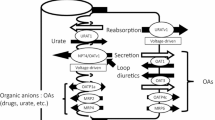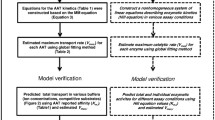Abstract
The rate of amino acid efflux from individual cells needs to be adapted to cellular demands and plays a central role for the control of extracellular amino acid homeostasis. A particular example of such an outward amino acid transport is the basolateral efflux from transporting epithelial cells located in the small intestine and kidney proximal tubule. Because LAT2-4F2hc (Slc7a8–Slc3a2), the best known basolateral neutral amino acid transporter of these epithelial cells, functions as an obligatory exchanger, we tested whether TAT1 (Slc16a10), the aromatic amino-acid facilitated diffusion transporter, might allow amino acid efflux via this exchanger by recycling its influx substrates. In this study, we show by immunofluorescence that TAT1 and LAT2 indeed colocalize in the early kidney proximal tubule. Using the Xenopus laevis oocytes expression system, we show that l-glutamine is released from oocytes into an amino-acid-free medium only when both transporters are coexpressed. High-performance liquid chromatography analysis reveals that several other neutral amino acids are released as well. The transport function of both TAT1 and LAT2-4F2hc is necessary for this efflux, as coexpression of functionally inactive but surface-expressed mutants is ineffective. Based on negative results of coimmunoprecipitation and crosslinking experiments, the physical interaction of these transporters does not appear to be required. Furthermore, replacement of TAT1 or LAT2-4F2hc by the facilitated diffusion transporter LAT4 or the obligatory exchanger LAT1, respectively, supports similar functional cooperation. Taken together, the results suggest that the aromatic amino acid diffusion pathway TAT1 can control neutral amino acid efflux via neighboring exchanger LAT2-4F2hc, by recycling its aromatic influx substrates.







Similar content being viewed by others
References
Barriere H, Nemes C, Lechardeur D, Khan-Mohammad M, Fruh K, Lukacs GL (2006) Molecular basis of oligoubiquitin-dependent internalization of membrane proteins in mammalian cells. Traffic 7:282–297
Bauch C, Forster N, Loffing-Cueni D, Summa V, Verrey F (2003) Functional cooperation of epithelial heteromeric amino acid transporters expressed in Madin–Darby canine kidney cells. J Biol Chem 278:1316–1322
Bodoy S, Martin L, Zorzano A, Palacin M, Estevez R, Bertran J (2005) Identification of LAT4, a novel amino acid transporter with system L activity. J Biol Chem 280:12002–12011
Broer A, Klingel K, Kowalczuk S, Rasko JE, Cavanaugh J, Broer S (2004) Molecular cloning of mouse amino acid transport system B0, a neutral amino acid transporter related to Hartnup disorder. J Biol Chem 279:24467–24476
Camargo SM, Makrides V, Virkki LV, Forster IC, Verrey F (2005) Steady-state kinetic characterization of the mouse B(0)AT1 sodium-dependent neutral amino acid transporter. Pflugers Arch 451:338–348
Chen SY, Bhargava A, Mastroberardino L, Meijer OC, Wang J, Buse P, Firestone GL, Verrey F, Pearce D (1999) Epithelial sodium channel regulated by aldosterone-induced protein sgk. Proc Natl Acad Sci USA 96:2514–2519
Cynober LA (2002) Plasma amino acid levels with a note on membrane transport: characteristics, regulation, and metabolic significance. Nutrition 18:761–766
Divino Filho J, Bergström J, Stehle P, Fürst P (1997) Simultaneous measurements of free amino acid patterns of plasma, muscle and erythrocytes in healthy human subjects. Clin Nutr 16(6):299–305
Fernandez E, Torrents D, Chillaron J, Martin Del Rio R, Zorzano A, Palacin M (2003) Basolateral LAT-2 has a major role in the transepithelial flux of L-cystine in the renal proximal tubule cell line OK. J Am Soc Nephrol 14:837–847
Fischer N, Setif P, Rochaix JD (1997) Targeted mutations in the psaC gene of Chlamydomonas reinhardtii: preferential reduction of FB at low temperature is not accompanied by altered electron flow from photosystem I to ferredoxin. Biochemistry 36:93–102
Furriols M, Chillaron J, Mora C, Castello A, Bertran J, Camps M, Testar X, Vilaro S, Zorzano A, Palacin M (1993) rBAT, related to L-cysteine transport, is localized to the microvilli of proximal straight tubules, and its expression is regulated in kidney by development. J Biol Chem 268:27060–27068
Hill WG, Southern NM, MacIver B, Potter E, Apodaca G, Smith CP, Zeidel ML (2005) Isolation and characterization of the Xenopus oocyte plasma membrane: a new method for studying activity of water and solute transporters. Am J Physiol Renal Physiol 289:F217–F224
Kim DK, Kanai Y, Chairoungdua A, Matsuo H, Cha SH, Endou H (2001) Expression cloning of a Na+-independent aromatic amino acid transporter with structural similarity to H+/monocarboxylate transporters. J Biol Chem 276:17221–17228
Kim do K, Kanai Y, Matsuo H, Kim JY, Chairoungdua A, Kobayashi Y, Enomoto A, Cha SH, Goya T, Endou H (2002) The human T-type amino acid transporter-1: characterization, gene organization, and chromosomal location. Genomics 79:95–103
Kleta R, Romeo E, Ristic Z, Ohura T, Stuart C, Arcos-Burgos M, Dave MH, Wagner CA, Camargo SR, Inoue S, Matsuura N, Helip-Wooley A, Bockenhauer D, Warth R, Bernardini I, Visser G, Eggermann T, Lee P, Chairoungdua A, Jutabha P, Babu E, Nilwarangkoon S, Anzai N, Kanai Y, Verrey F, Gahl WA, Koizumi A (2004) Mutations in SLC6A19, encoding B(0)AT1, cause Hartnup disorder. Nat Genet 36:999–1002
Medintz I, Wang X, Hradek T, Michels CA (2000) A PEST-like sequence in the N-terminal cytoplasmic domain of Saccharomyces maltose permease is required for glucose-induced proteolysis and rapid inactivation of transport activity. Biochemistry 39:4518–4526
Meier C, Ristic Z, Klauser S, Verrey F (2002) Activation of system L heterodimeric amino acid exchangers by intracellular substrates. EMBO J 21:580–589
Palacin M, Nunes V, Font-Llitjos M, Jimenez-Vidal M, Fort J, Gasol E, Pineda M, Feliubadalo L, Chillaron J, Zorzano A (2005) The genetics of heteromeric amino acid transporters. Physiology (Bethesda) 20:112–124
Pfeiffer R, Loffing J, Rossier G, Bauch C, Meier C, Eggermann T, Loffing-Cueni D, Kuhn LC, Verrey F (1999) Luminal heterodimeric amino acid transporter defective in cystinuria. Mol Biol Cell 10:4135–4147
Pfeiffer R, Rossier G, Spindler B, Meier C, Kuhn L, Verrey F (1999) Amino acid transport of y+L-type by heterodimers of 4F2hc/CD98 and members of the glycoprotein-associated amino acid transporter family. EMBO J 18:49–57
Pohl P, Saparov SM, Antonenko YN (1998) The size of the unstirred layer as a function of the solute diffusion coefficient. Biophys J 75:1403–1409
Ramadan T, Camargo SM, Summa V, Hunziker P, Chesnov S, Pos KM, Verrey F (2006) Basolateral aromatic amino acid transporter TAT1 (Slc16a10) functions as an efflux pathway. J Cell Physiol 206:771–779
Rechsteiner M, Rogers SW (1996) PEST sequences and regulation by proteolysis. Trends Biochem Sci 21:267–271
Rossier G, Meier C, Bauch C, Summa V, Sordat B, Verrey F, Kuhn LC (1999) LAT2, a new basolateral 4F2hc/CD98-associated amino acid transporter of kidney and intestine. J Biol Chem 274:34948–34954
Takada A, Grdisa M, Diksic M, Gjedde A, Yamamoto YL (1993) Rapid steady-state analysis of blood–brain transfer of L-Trp in rat, with special reference to the plasma protein binding. Neurochem Int 23:351–359
Taylor PM, Kaur S, Mackenzie B, Peter GJ (1996) Amino-acid-dependent modulation of amino acid transport in Xenopus laevis oocytes. J Exp Biol 199:923–931
Verrey F (2003) System L: heteromeric exchangers of large, neutral amino acids involved in directional transport. Pflugers Arch 445:529–533
Verrey F, Ristic Z, Romeo E, Ramadan T, Makrides V, Dave MH, Wagner CA, Camargo SM (2005) Novel renal amino acid transporters. Annu Rev Physiol 67:557–572
Wagner CA, Finberg KE, Stehberger PA, Lifton RP, Giebisch GH, Aronson PS, Geibel JP (2002) Regulation of the expression of the Cl−/anion exchanger pendrin in mouse kidney by acid–base status. Kidney Int 62:2109–2117
Acknowledgment
This work was supported by grants from the Swiss National Science Foundation (grant number 31-59141.99/02 to FV) and EUGINDAT (The European FP6 Project).
Author information
Authors and Affiliations
Corresponding author
Rights and permissions
About this article
Cite this article
Ramadan, T., Camargo, S.M.R., Herzog, B. et al. Recycling of aromatic amino acids via TAT1 allows efflux of neutral amino acids via LAT2-4F2hc exchanger. Pflugers Arch - Eur J Physiol 454, 507–516 (2007). https://doi.org/10.1007/s00424-007-0209-3
Received:
Accepted:
Published:
Issue Date:
DOI: https://doi.org/10.1007/s00424-007-0209-3




